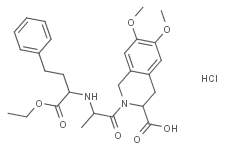
Moexipril HCl
CAS No. 82586-52-5
Moexipril HCl( RS-10085 )
Catalog No. M19148 CAS No. 82586-52-5
Moexipril HCl is a potent orally active nonsulfhydrylangiotensin converting enzyme (ACE)inhibitor, used for the treatment of hypertension and congestive heart failure.
Purity : >98% (HPLC)
 COA
COA
 Datasheet
Datasheet
 HNMR
HNMR
 HPLC
HPLC
 MSDS
MSDS
 Handing Instructions
Handing Instructions
| Size | Price / USD | Stock | Quantity |
| 10MG | 45 | In Stock |


|
| 50MG | 57 | In Stock |


|
| 100MG | 73 | In Stock |


|
| 200MG | 102 | In Stock |


|
| 500MG | Get Quote | In Stock |


|
| 1G | Get Quote | In Stock |


|
Biological Information
-
Product NameMoexipril HCl
-
NoteResearch use only, not for human use.
-
Brief DescriptionMoexipril HCl is a potent orally active nonsulfhydrylangiotensin converting enzyme (ACE)inhibitor, used for the treatment of hypertension and congestive heart failure.
-
DescriptionMoexipril HCl is a potent orally active nonsulfhydrylangiotensin converting enzyme (ACE)inhibitor, used for the treatment of hypertension and congestive heart failure.(In Vitro):Moexipril hydrochloride is devoid of anti-inflammatory properties and has no effect on platelet function.Moexipril hydrochloride hydrolyzes to Moexiprilat, and Moexiprilat inhibits ACE in guinea pig serum as well as on purified ACE from rabbit lung with IC50s of 2.6 and 4.9 nM, respectively.Moexipril hydrochloride (0.01 nM-0.1 mM) exhibits high potency against both plasma ACE and purified ACE from rabbit lung, with IC50s of 2.7 mM and 0.165 mM, respectively.Moexipril hydrochloride (0-100 μM, 24 h) significantly reduced the percentage of damaged neurons in a dose-dependent manner.Moexipril hydrochloride (0-100 μM, 24 h) significantly attenuates Fe2+/3+-induced neurotoxicity.Moexipril hydrochloride dose not cause significant changes in the percentage of apoptotic neurons.(In Vivo):Moexipril hydrochloride can not cross the blood-brain barrier.Moexipril hydrochloride (3 mg/kg, 30 mg/kg and 10 mg/kg, respectively; p.o.; once daily; 5 days) exhibits the a dose-dependent and antihypertensive effects in renal hypertensive rats, spontaneously hypertensive rats and perinephritic hypertensive dogs, respectively.Moexipril hydrochloride (0.3 mg/kg, i.p.) significantly reduces the infarct area on the mouse brain surface in NMRI mice.Moexipril hydrochloride (0.1 mg/kg, i.p.) significantly attenuates the cortical infarct volume in Long-Evans rats.
-
In VitroMoexipril hydrochloride is devoid of anti-inflammatory properties and has no effect on platelet function.Moexipril hydrochloride hydrolyzes to Moexiprilat, and Moexiprilat inhibits ACE in guinea pig serum as well as on purified ACE from rabbit lung with IC50s of 2.6 and 4.9 nM, respectively.Moexipril hydrochloride (0.01 nM-0.1 mM) exhibits high potency against both plasma ACE and purified ACE from rabbit lung, with IC50s of 2.7 mM and 0.165 mM, respectively.Moexipril hydrochloride (0-100 μM, 24 h) significantly reduced the percentage of damaged neurons in a dose-dependent manner.Moexipril hydrochloride (0-100 μM, 24 h) significantly attenuates Fe2+/3+-induced neurotoxicity.Moexipril hydrochloride dose not cause significant changes in the percentage of apoptotic neurons.
-
In VivoMoexipril hydrochloride can not cross the blood-brain barrier.Moexipril hydrochloride (3 mg/kg, 30 mg/kg and 10 mg/kg, respectively; p.o.; once daily; 5 days) exhibits the a dose-dependent and antihypertensive effects in renal hypertensive rats, spontaneously hypertensive rats and perinephritic hypertensive dogs, respectively.Moexipril hydrochloride (0.3 mg/kg, i.p.) significantly reduces the infarct area on the mouse brain surface in NMRI mice.Moexipril hydrochloride (0.1 mg/kg, i.p.) significantly attenuates the cortical infarct volume in Long-Evans rats. Animal Model:Spontaneously hypertensive rats Dosage:30 mg/kg Administration:Oral gavage; once daily; 5 days Result:Caused a progressive lowering of mean blood pressure from pretreatment values of 180 +/- 7 mmHg to a trough on day 4 of 127 +/- 4 mmHg.Dose-dependently decreased arterial blood pressure, and inhibited plasma and tissue ACE activity.Animal Model:Renal hypertensive rats Dosage:0.03-10 mg/kg Administration:Oral gavage; once daily; 5 days Result:Caused a dose-dependent decrease in blood pressure with a threshold dose of 0.3 mg/kg. Lowered mean blood pressure by about 70 mmHg of 3 mg/kg.Animal Model:Perinephritic hypertensive dogs Dosage:10 mg/kg Administration:Oral gavage; once daily; 5 days Result:Caused a drop of mean blood pressure by 25 mmHg from pre-treatment control, which persisted for 24 h, by a rapid onset and a long duration of action.Animal Model:NMRI mice (male, Permanent focal ischemia) Dosage:0, 0.03, 0.3, and 3 mg/kg Administration:Intraperitoneal injection (1 h before middle cerebral artery occlusion)Result:Significantly reduced the infarct area on the mouse brain surface with a dose of 0.3 mg/kg, and other doses were not effective.Animal Model:Long-Evans rats (male, Permanent focal ischemia)Dosage:0, 0.01, 0.1 mg/kg Administration:Intraperitoneal injection (1 h before middle cerebral artery occlusion)Result:Significantly attenuated the cortical infarct volume from 114.4 to 98.2 mm as compared to non-treated animals in a dose of 0.01 mg/kg, without reducing the infarct volume of the rat brain at dosages >0.01 mg/kg.
-
SynonymsRS-10085
-
PathwayOthers
-
TargetOther Targets
-
RecptorACE
-
Research AreaCardiovascular Disease
-
Indication——
Chemical Information
-
CAS Number82586-52-5
-
Formula Weight535.03
-
Molecular FormulaC27H34N2O7·HCl
-
Purity>98% (HPLC)
-
SolubilityDMSO : ≥ 100 mg/mL; 186.91 mM
-
SMILESCl.CCOC(=O)[C@H](CCC1=CC=CC=C1)N[C@@H](C)C(=O)N1CC2=CC(OC)=C(OC)C=C2C[C@H]1C(O)=O
-
Chemical Name——
Shipping & Storage Information
-
Storage(-20℃)
-
ShippingWith Ice Pack
-
Stability≥ 2 years
Reference
1.Ta?demir HI, Kili? E.Pharmazie. 2014 Sep;69(9):648-54.
molnova catalog



related products
-
Diaveridine
Diaveridine (DVD) is a popular antibacterial synergist that is widely used in combination with sulfonamide.
-
1,3,3,5,5-pentamethy...
1,3,3,5,5-pentamethylcyclohexan-1-amine hydrochloride is a chemical compound.
-
Adrenomedullin (AM) ...
Adrenomedullin (AM) (1-52), human (TFA) is an NH2 terminal truncated adrenomedullin analogue,affects cell proliferation and angiogenesis in cancer.



 Cart
Cart
 sales@molnova.com
sales@molnova.com


